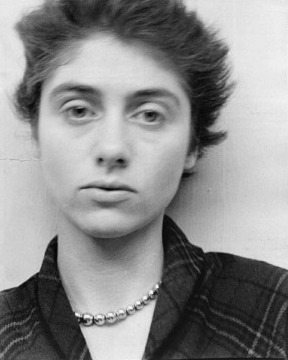those certain females: diane arbus
 A boy’s face contorts itself into a twist of anger. The left strap of his dungarees slips down over his shoulder. The dappled afternoon light skims across the path behind him. He clenches a toy grenade in his fist.
A boy’s face contorts itself into a twist of anger. The left strap of his dungarees slips down over his shoulder. The dappled afternoon light skims across the path behind him. He clenches a toy grenade in his fist.
A couple clutch each other on the streets. It looks cold out and they wear the clothes and expressions of middle age. But their dimpled faces betray them. They can’t be more than sixteen.
Two bodies wrap around each other, their tiny baby-limbs stretched and frozen. Pickled. Shrouded for eternity by formaldehyde and a thick glass jar. Siamese Twins in a Coney Island sideshow.
This is the photographic world of Diane Arbus: her New York, as ordinary as it is strange. And closer inspection is always needed.
Widely considered amongst the most important photographers of the 20th Century, Arbus famously chose to feature subjects varying from tattooed men and bearded ladies, to nudist camp residents, to drag queens, to sanatorium patients at Halloween; those who exist merely in society’s peripheral vision. But these are just the images people tend to remember. Actually, she seemed equally as interested in the mundane as she was the bizarre. The notes accompanying a recent retrospective held in Berlin put it aptly, describing ‘her gift for rendering strange those that we consider most familiar, and for uncovering the familiar within the exotic.’ Arbus was just as preoccupied with street photography of regular folk in Central Park as she was with freaks in the circus.
The story of her personal life becomes as tragic as it starts off seemingly ideal. Arbus was born in 1923, into a wealthy family; owner’s of a famous New York Department store. Marrying at the tender age of 18, her husband Allan was her adolescent sweetheart, and a photographer. He taught Diane her way around a camera and the couple formed a successful business partnership, opening up a commercial photography studio in Manhattan.
Essentially, they made their living making people look beautiful and proving it to them. However, after the birth of their second child in 1954, the marriage started to dissolve, so too did Diane’s relationship with the commercial photography world and she quit the business in 1956.
No longer forced to make people look beautiful, she chose to simply document them as she saw them, often without offering prior warning. Her image, Three Puerto Rican Women, displays a street scene featuring a huddle of three smartly dressed ladies, but they wear appalled expressions on their faces, seemingly just having noticed Arbus’ lens pointing in their direction. This candid nature colours many of her photographs.
Throughout the 60s she began to take on more journalistic projects and produced some of her most interesting photographic work. However, she faced increasing health problems. Diagnosed with hepatitis, she began to experience periods of wallowing depression and, tragically, took her own life in 1971. She was found dead in a bathtub at the age of 48.
Even though it’s interesting to view her life’s trajectory—leaving a husband to pursue career interests etc.—against the contextual backdrop of the changing socio-political world and women’s role within it, Arbus never called herself a feminist. Thus, it would be slightly misguided to project onto her life any ideas of a feminism-induced awakening, or anything like that.
However, she did have an interesting brush with 1970s feminism embodied in all its ferocious glory: a meeting with the poster girl of the Second Wave movement, Germaine Greer. Greer is the subject of Arbus’ portrait, Feminist in a Hotel Room (Arbus generally used sparse, non-descript titles like this for her photos, which on the one hand can be considered reductive and unimaginative, or brilliantly minimalistic—depending on who you ask). The shot of Greer is tightly framed and close enough to ooze pores and soft wrinkles.
Writing for the Guardian after an Arbus retrospective in 2005, Greer remembers this encounter, and not particularly fondly. She writes of Arbus:
‘She seemed too birdlike and delicate to be lugging her outsize camera bag on such a warm day…Clutching the camera she climbed on to the bed and straddled me, moving up until she was kneeling with a knee on both sides of my chest. She held the Rolleiflex at waist height with the lens right in my face…’
With typical Greerian brutality, she spends the rest of the Guardian article executing a scathing critique of Arbus’ photos and continues:
‘After an eternity she climbed off me, put the camera back in her bag and buggered off. A few weeks later she took an overdose of barbiturates and slit her wrists.’
Greer’s abrupt assessment of Arbus’ work is potentially just the riposte of someone who is deeply unsatisfied with the photographic results of themselves, but it nevertheless offers an interesting insight into Arbus’ process.
It is often contested whether Arbus regarded her subjects with a certain sense of fondness or a certain sense of repulsion. What is undeniable is that she harboured a voracious curiosity about the world around her, including a fascination of perceived otherness. This fascination is an admirable thing for anyone to cultivate and allows Arbus’ images to remain powerful decades after they were taken, whether Germaine Greer is satisfied with the results or not.
(Image credit)
